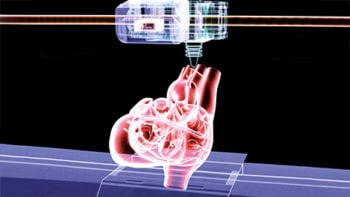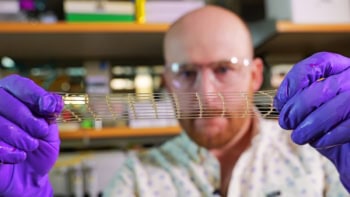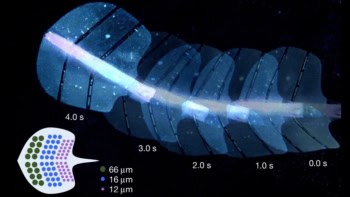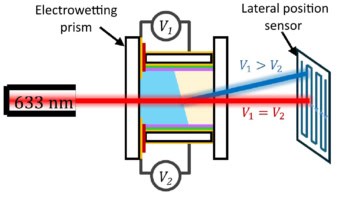Researchers in the US have shown that they can manufacture sub-micron fibres of collagen faster than ever before using a technique they have dubbed “pneumatospinning”. The technique, which makes use of high-speed air jets to form the microfibres, can produce both isotropic and anisotropic collagen strands – which is essential if the material is to be exploited in biomedical applications such as tissue repair. The technology could be used to make new medical devices as well as repair existing ones, and to make topical dressings for burns, ulcers and wounds.

Collagen is currently manufactured using electrospinning, a well-established bottom-up fibre production method that dates back to at least the beginning of the last century. It can be used to generate 3D fibrous scaffolds for tissue-engineering applications, and can produce fibres with diameters ranging from tens of nanometres to several microns.
There is a problem, however, in that electrospinning normally involves using caustic solvents. These denature the fibres, resulting in structures that are weaker and less stable than native collagen fibrils. The technique also typically creates unaligned fibres, which cannot be used for applications such as connective tissue repair that require highly aligned material. Perhaps most importantly, pure collagen microfibres can only be synthesized very slowly using this process, which means that it cannot be used to produce large quantities of material on a commercial scale.
Creating cytocompatible microfibres
Researchers led by Michael Francis, who is the chief science officer of Embody LLC in Norfolk, Virginia, have now found that a benign solvent (acetic acid) can be used to dissolve type I collagen (Biofabrication 10 045004). The solvent can then be volatized using high-speed compressed air jets, allowing the collagen I to polymerize into cytocompatible microfibres. This pneumatospinning technique uses the air jets not only to extend the flow of a biopolymer (in this case pure telocollagen and atelocollagen) but also to evaporate the solvent from the polymer solution to produce sub-micron fibres.
Francis and colleagues have also produced a blended microfibrous biomaterial by pneumatospinning collagen with poly(D,L-Lactide) using dimethyl sulfoxide (DMSO), another benign solvent. All type I collagen starting material was obtained from calfskin.
“We spent a lot of time and energy developing the benign solvents for this study so that our approach might better translate to clinical applications,” says Francis.
Better tensile properties
In the next part of the study, the researchers cross-linked the microfibres to create collagen scaffolds. Subsequent analysis revealed that the scaffolds contain regularly sized fibres that had not undergone any deleterious chemical changes during the pneumatospinning process.
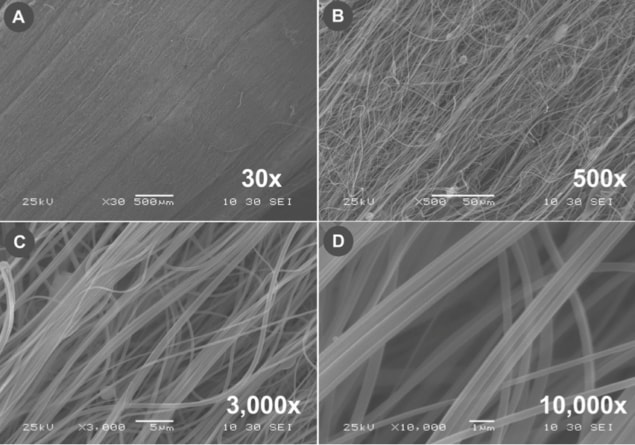
The pneumatospun collagen has many advantages over collagen produced by conventional methods, says Francis. “The first is that it can be better assembled from the bottom up. This means that it has an improved molecular structure and better tensile properties compared to electrospun material. What’s more, stem cells cultured on this collagen also attach robustly, which proves that the material is biocompatible.” The technique can be used to produce both isotropic and anisotropic collagen strands, which is particularly valuable for applications that require highly aligned fibres.
Francis believes that the technology offers huge potential both for fabricating new medical devices and for coating existing devices to repair them. “The collagen produced could also be used to repair ligaments, tendons and nerves, as well as to make fibrous dressings for burns and ulcers and topical meshes for wounds,” he told Physics World. “It might even be used to coat other materials, such as polymers and metals, to improve graft integration and compatibility.”
The researchers, reporting their work in the IOP journal Biofabrication, say that they are now hope to exploit the collagen structures for in vivo wound healing. “We have also started to look at pneumatospinning pure collagen, again from benign solvents, that is stable in water without cross-linking. We have already obtained successful preliminary results here and further studies will ultimately help us to translate this technology to the clinic.”
- Read our special collection “Frontiers in biofabrication” to learn more about the latest advances in tissue engineering. This article is one of a series of reports highlighting high-impact research published in Biofabrication.
